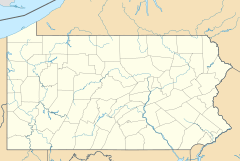Hazel Kirk, Pennsylvania facts for kids
Quick facts for kids
Hazel Kirk
|
|
|---|---|
| Country | United States |
| State | Pennsylvania |
| County | Washington |
| Elevation | 791 ft (241 m) |
| Time zone | UTC-5 (Eastern (EST)) |
| • Summer (DST) | UTC-4 (EDT) |
| ZIP codes |
15366
|
| GNIS feature ID | 1176711 |
Hazel Kirk is a small place in Washington County, in the southwestern part of Pennsylvania. It's known as an unincorporated community, which means it's a settlement without its own local government. Hazel Kirk was also a "coal town." This means it grew up around coal mines. Many people who lived there worked in the mines.
Hazel Kirk was part of Carroll Township. It was home to four important coal mines. These mines were called "Hazel Kirk Mine," "Hazel Kirk No. 1," "Hazel Kirk No. 2," and "Hazel Kirk No. 3." They dug for a type of coal called bituminous coal.
The 1905 Hazel Kirk Mine Accident
The Hazel Kirk Mine No. 2, owned by the Pittsburg and Westmoreland Coal Company, had two serious accidents in October 1905. These events show how dangerous coal mining could be.
First Incident: October 10, 1905
On October 10, 1905, an explosion happened deep inside the mine. This blast was caused by dynamite used for mining. Sadly, two miners, brothers John and Mike Kusko, lost their lives. A fire started because of the explosion. To stop the fire, workers built temporary walls, called bulkheads. They then filled the burning part of the mine with water.
Second Incident: October 28/29, 1905
After almost three weeks, people thought the fire had gone out. John Hornickel, the 45-year-old superintendent of Hazel Kirk No. 2, went into the mine. He went with five other mine managers late at night on October 28. Their goal was to check the situation. All other work in the mine had stopped.
During their inspection, they removed a temporary wall. Behind this wall, dangerous explosive gas had been trapped. This caused another explosion. Five of the mine officials died. The sixth person was badly burned. These events highlight the risks miners and mine officials faced. They also show the importance of strict safety rules in mining.



